height LINCOLN MKZ HYBRID 2014 Owners Manual
[x] Cancel search | Manufacturer: LINCOLN, Model Year: 2014, Model line: MKZ HYBRID, Model: LINCOLN MKZ HYBRID 2014Pages: 445, PDF Size: 3.8 MB
Page 3 of 445
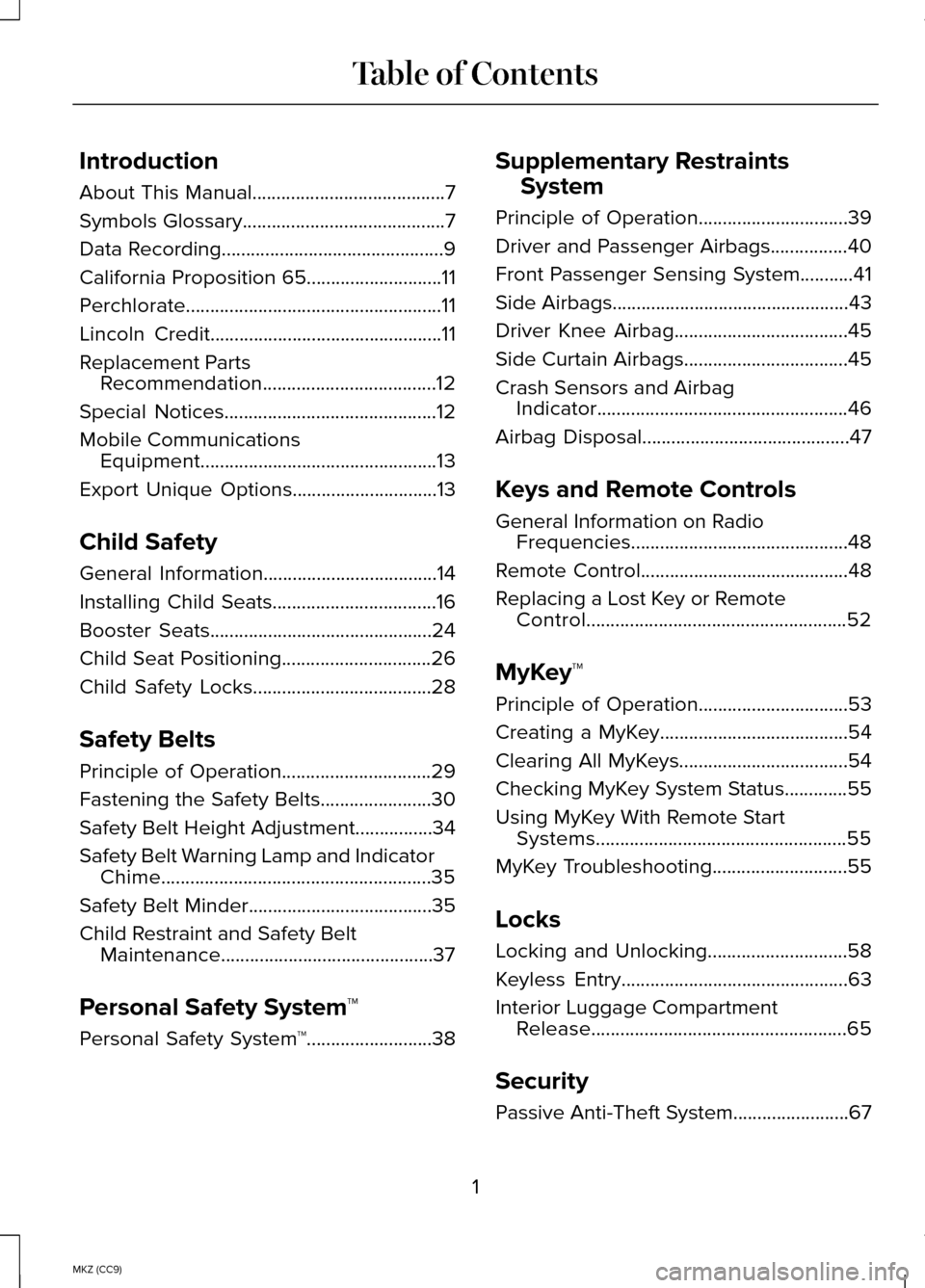
Introduction
About This Manual........................................7
Symbols Glossary..........................................7
Data Recording
..............................................9
California Proposition 65
............................11
Perchlorate
.....................................................11
Lincoln Credit
................................................11
Replacement Parts Recommendation....................................12
Special Notices
............................................12
Mobile Communications Equipment.................................................13
Export Unique Options..............................13
Child Safety
General Information
....................................14
Installing Child Seats
..................................16
Booster Seats
..............................................24
Child Seat Positioning
...............................26
Child Safety Locks.....................................28
Safety Belts
Principle of Operation...............................29
Fastening the Safety Belts.......................30
Safety Belt Height Adjustment................34
Safety Belt Warning Lamp and Indicator Chime........................................................35
Safety Belt Minder
......................................35
Child Restraint and Safety Belt Maintenance............................................37
Personal Safety System ™
Personal Safety System ™
..........................38Supplementary Restraints
System
Principle of Operation...............................39
Driver and Passenger Airbags................40
Front Passenger Sensing System...........41
Side Airbags
.................................................43
Driver Knee Airbag
....................................45
Side Curtain Airbags
..................................45
Crash Sensors and Airbag Indicator....................................................46
Airbag Disposal
...........................................47
Keys and Remote Controls
General Information on Radio Frequencies.............................................48
Remote Control...........................................48
Replacing a Lost Key or Remote Control......................................................52
MyKey™
Principle of Operation
...............................53
Creating a MyKey
.......................................54
Clearing All MyKeys...................................54
Checking MyKey System Status.............55
Using MyKey With Remote Start Systems....................................................55
MyKey Troubleshooting............................55
Locks
Locking and Unlocking.............................58
Keyless Entry...............................................63
Interior Luggage Compartment Release
.....................................................65
Security
Passive Anti-Theft System
........................67
1
MKZ (CC9) Table of Contents
Page 16 of 445
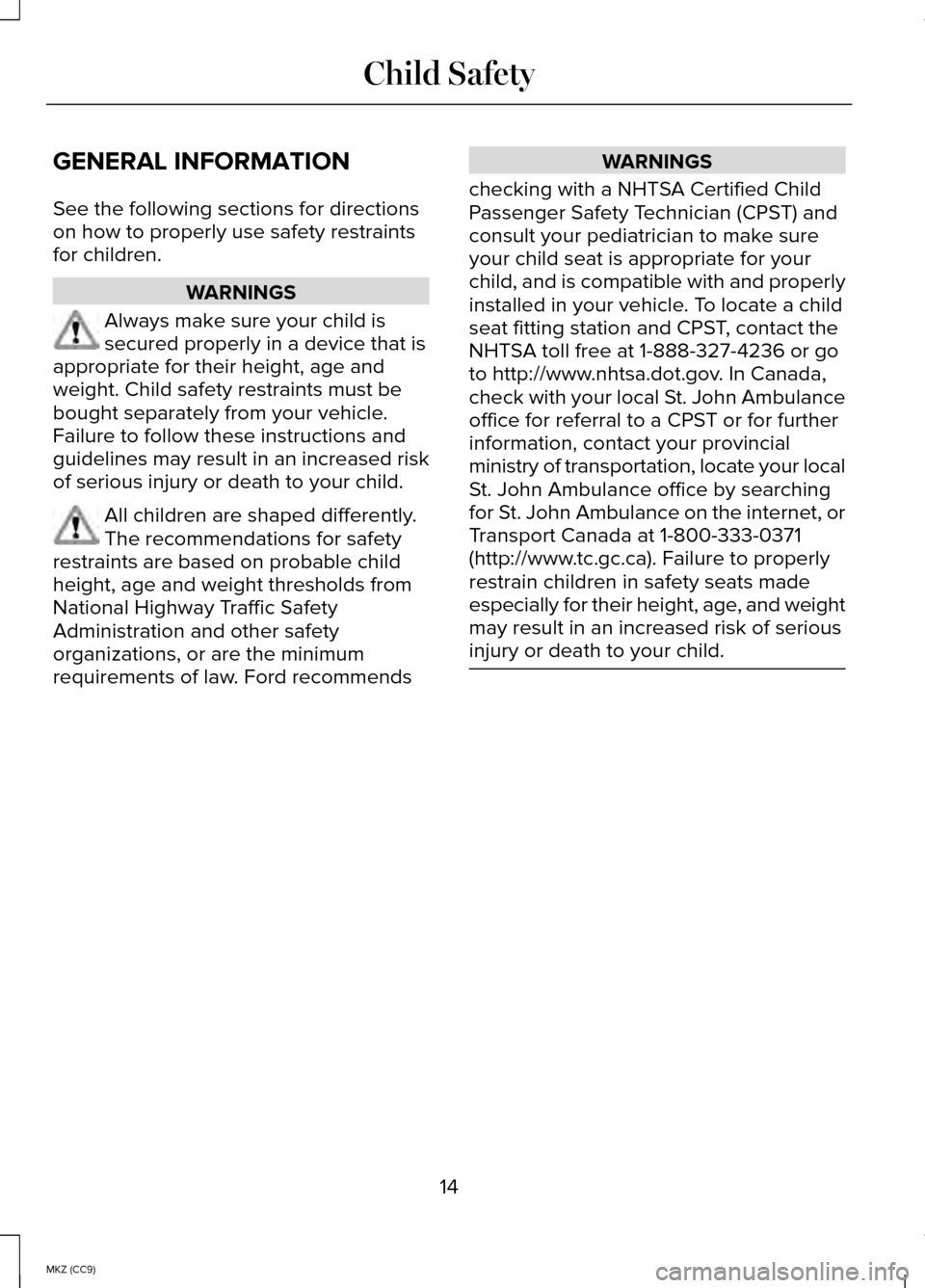
GENERAL INFORMATION
See the following sections for directions
on how to properly use safety restraints
for children.
WARNINGS
Always make sure your child is
secured properly in a device that is
appropriate for their height, age and
weight. Child safety restraints must be
bought separately from your vehicle.
Failure to follow these instructions and
guidelines may result in an increased risk
of serious injury or death to your child. All children are shaped differently.
The recommendations for safety
restraints are based on probable child
height, age and weight thresholds from
National Highway Traffic Safety
Administration and other safety
organizations, or are the minimum
requirements of law. Ford recommends WARNINGS
checking with a NHTSA Certified Child
Passenger Safety Technician (CPST) and
consult your pediatrician to make sure
your child seat is appropriate for your
child, and is compatible with and properly
installed in your vehicle. To locate a child
seat fitting station and CPST, contact the
NHTSA toll free at 1-888-327-4236 or go
to http://www.nhtsa.dot.gov. In Canada,
check with your local St. John Ambulance
office for referral to a CPST or for further
information, contact your provincial
ministry of transportation, locate your local
St. John Ambulance office by searching
for St. John Ambulance on the internet, or
Transport Canada at 1-800-333-0371
(http://www.tc.gc.ca). Failure to properly
restrain children in safety seats made
especially for their height, age, and weight
may result in an increased risk of serious
injury or death to your child. 14
MKZ (CC9) Child Safety
Page 17 of 445
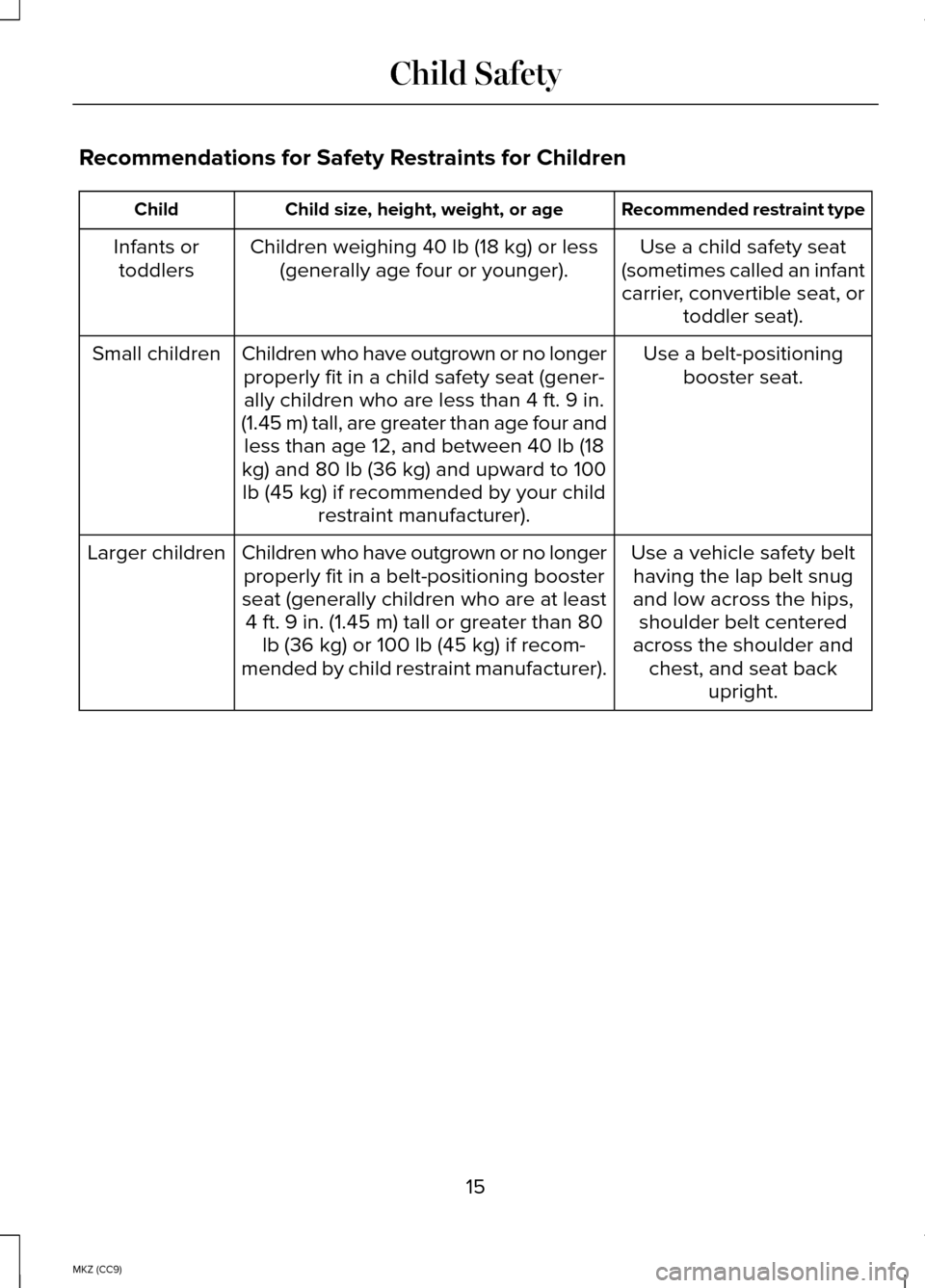
Recommendations for Safety Restraints for Children
Recommended restraint type
Child size, height, weight, or age
Child
Use a child safety seat
(sometimes called an infant carrier, convertible seat, or toddler seat).
Children weighing 40 lb (18 kg) or less
(generally age four or younger).
Infants or
toddlers
Use a belt-positioningbooster seat.
Children who have outgrown or no longer
properly fit in a child safety seat (gener-ally children who are less than 4 ft. 9 in.
(1.45 m) tall, are greater than age four and less than age 12, and between 40 lb (18
kg) and 80 lb (36 kg) and upward to 100 lb (45 kg) if recommended by your child restraint manufacturer).
Small children
Use a vehicle safety belthaving the lap belt snug
and low across the hips, shoulder belt centered
across the shoulder and chest, and seat back upright.
Children who have outgrown or no longer
properly fit in a belt-positioning booster
seat (generally children who are at least 4 ft. 9 in. (1.45 m) tall or greater than 80 lb (36 kg) or 100 lb (45 kg) if recom-
mended by child restraint manufacturer).
Larger children
15
MKZ (CC9) Child Safety
Page 18 of 445
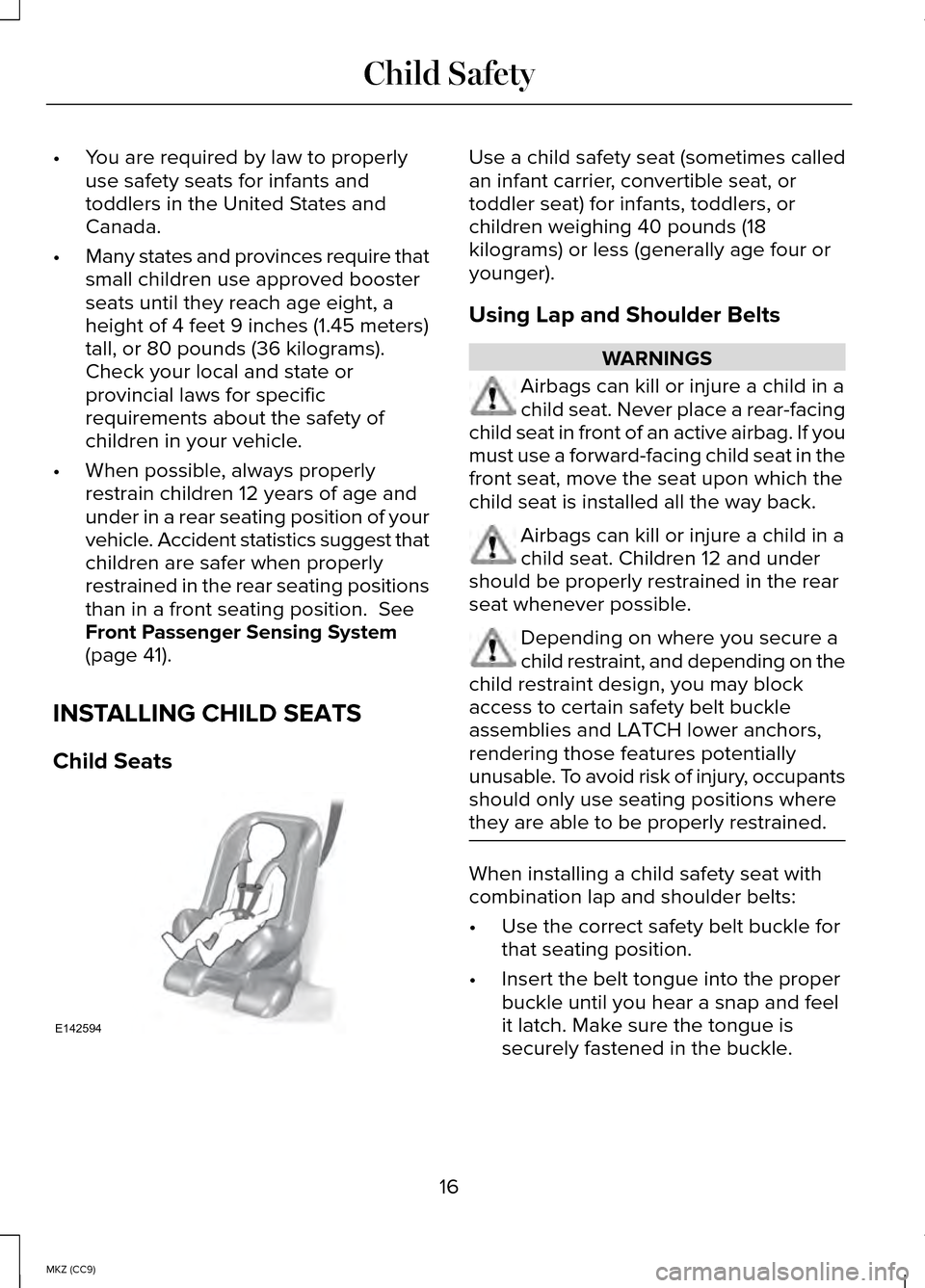
•
You are required by law to properly
use safety seats for infants and
toddlers in the United States and
Canada.
• Many states and provinces require that
small children use approved booster
seats until they reach age eight, a
height of 4 feet 9 inches (1.45 meters)
tall, or 80 pounds (36 kilograms).
Check your local and state or
provincial laws for specific
requirements about the safety of
children in your vehicle.
• When possible, always properly
restrain children 12 years of age and
under in a rear seating position of your
vehicle. Accident statistics suggest that
children are safer when properly
restrained in the rear seating positions
than in a front seating position. See
Front Passenger Sensing System
(page
41).
INSTALLING CHILD SEATS
Child Seats Use a child safety seat (sometimes called
an infant carrier, convertible seat, or
toddler seat) for infants, toddlers, or
children weighing 40 pounds (18
kilograms) or less (generally age four or
younger).
Using Lap and Shoulder Belts
WARNINGS
Airbags can kill or injure a child in a
child seat. Never place a rear-facing
child seat in front of an active airbag. If you
must use a forward-facing child seat in the
front seat, move the seat upon which the
child seat is installed all the way back. Airbags can kill or injure a child in a
child seat. Children 12 and under
should be properly restrained in the rear
seat whenever possible. Depending on where you secure a
child restraint, and depending on the
child restraint design, you may block
access to certain safety belt buckle
assemblies and LATCH lower anchors,
rendering those features potentially
unusable. To avoid risk of injury, occupants
should only use seating positions where
they are able to be properly restrained. When installing a child safety seat with
combination lap and shoulder belts:
•
Use the correct safety belt buckle for
that seating position.
• Insert the belt tongue into the proper
buckle until you hear a snap and feel
it latch. Make sure the tongue is
securely fastened in the buckle.
16
MKZ (CC9) Child SafetyE142594
Page 26 of 445

2. Locate the correct anchor for the
selected seating position, then open
the tether anchor cover. 3. Clip the tether strap to the anchor as
shown.
4. Tighten the child safety seat tether strap according to the manufacturer's
instructions.
If your child restraint system is equipped
with a tether strap, and the child restraint
manufacturer recommends its use, Ford
also recommends its use.
BOOSTER SEATS WARNING
Never place, or allow a child to
place, the shoulder belt under a
child's arm or behind the back because it
reduces the protection for the upper part
of the body and may increase the risk of
injury or death in a collision. Note:
Some booster seat safety belt
guides may not accommodate the
shoulder portion of the inflatable safety
belt. Use a belt-positioning booster seat for
children who have outgrown or no longer
properly fit in a child safety seat (generally
children who are less than 4 feet 9 inches
(1.45 meters) tall, are greater than age four
(4) and less than age twelve (12), and
between 40 pounds (18 kilograms) and 80
pounds (36 kilograms) and upward to 100
pounds (45 kilograms) if recommended by
your child restraint manufacturer). Many
state and provincial laws require that
children use approved booster seats until
they reach age eight, a height of 4 feet 9
inches (1.45 meters) tall, or 80 pounds (36
kilograms).
Booster seats should be used until you
can answer YES to ALL of these questions
when seated without a booster seat:
•
Can the child sit all the way back
against their vehicle seat back with
knees bent comfortably at the edge of
the seat cushion?
• Can the child sit without slouching?
• Does the lap belt rest low across the
hips?
• Is the shoulder belt centered on the
shoulder and chest?
• Can the child stay seated like this for
the whole trip?
24
MKZ (CC9) Child SafetyE144275 E142595
Page 28 of 445
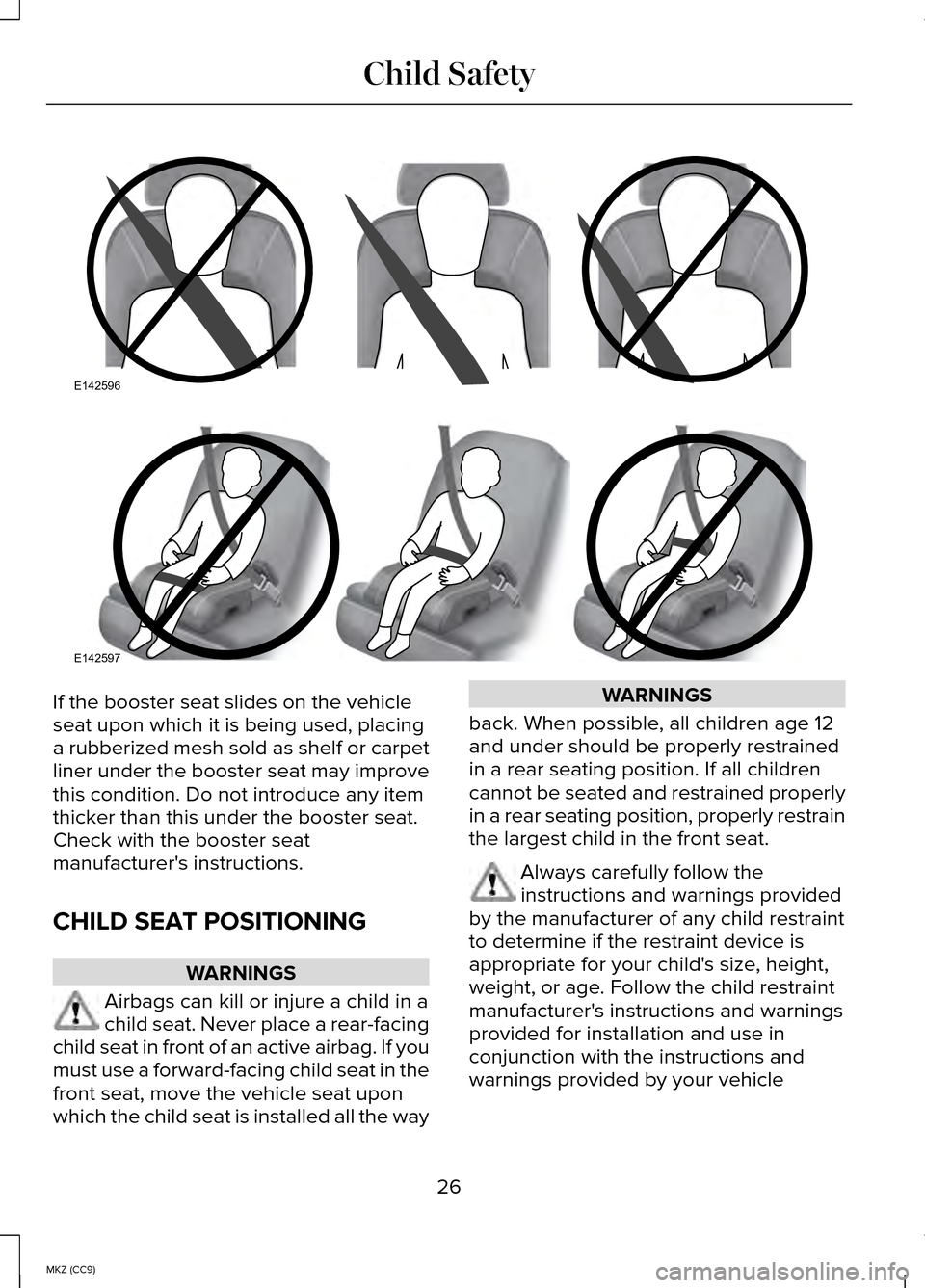
If the booster seat slides on the vehicle
seat upon which it is being used, placing
a rubberized mesh sold as shelf or carpet
liner under the booster seat may improve
this condition. Do not introduce any item
thicker than this under the booster seat.
Check with the booster seat
manufacturer's instructions.
CHILD SEAT POSITIONING
WARNINGS
Airbags can kill or injure a child in a
child seat. Never place a rear-facing
child seat in front of an active airbag. If you
must use a forward-facing child seat in the
front seat, move the vehicle seat upon
which the child seat is installed all the way WARNINGS
back. When possible, all children age 12
and under should be properly restrained
in a rear seating position. If all children
cannot be seated and restrained properly
in a rear seating position, properly restrain
the largest child in the front seat. Always carefully follow the
instructions and warnings provided
by the manufacturer of any child restraint
to determine if the restraint device is
appropriate for your child's size, height,
weight, or age. Follow the child restraint
manufacturer's instructions and warnings
provided for installation and use in
conjunction with the instructions and
warnings provided by your vehicle
26
MKZ (CC9) Child SafetyE142596 E142597
Page 29 of 445
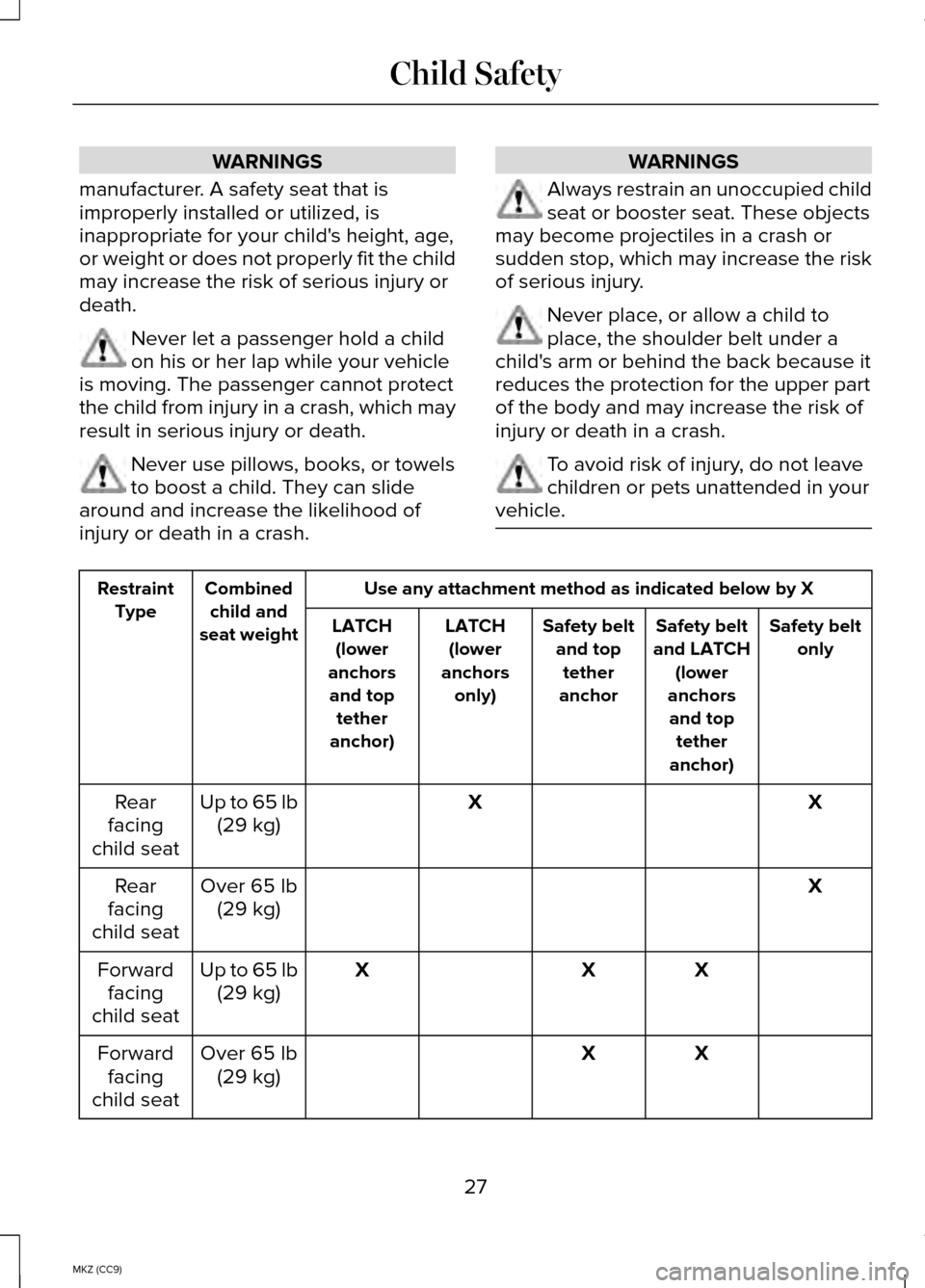
WARNINGS
manufacturer. A safety seat that is
improperly installed or utilized, is
inappropriate for your child's height, age,
or weight or does not properly fit the child
may increase the risk of serious injury or
death. Never let a passenger hold a child
on his or her lap while your vehicle
is moving. The passenger cannot protect
the child from injury in a crash, which may
result in serious injury or death. Never use pillows, books, or towels
to boost a child. They can slide
around and increase the likelihood of
injury or death in a crash. WARNINGS
Always restrain an unoccupied child
seat or booster seat. These objects
may become projectiles in a crash or
sudden stop, which may increase the risk
of serious injury. Never place, or allow a child to
place, the shoulder belt under a
child's arm or behind the back because it
reduces the protection for the upper part
of the body and may increase the risk of
injury or death in a crash. To avoid risk of injury, do not leave
children or pets unattended in your
vehicle. Use any attachment method as indicated below by X
Combined
child and
seat weight
Restraint
Type Safety belt
only
Safety belt
and LATCH (lower
anchors and top tether
anchor)
Safety belt
and toptether
anchor
LATCH
(lower
anchors only)
LATCH
(lower
anchors and top tether
anchor)
X
X
Up to 65 lb
(29 kg)
Rear
facing
child seat
X
Over 65 lb
(29 kg)
Rear
facing
child seat
X
X
X
Up to 65 lb
(29 kg)
Forward
facing
child seat
X
X
Over 65 lb
(29 kg)
Forward
facing
child seat
27
MKZ (CC9) Child Safety
Page 32 of 445
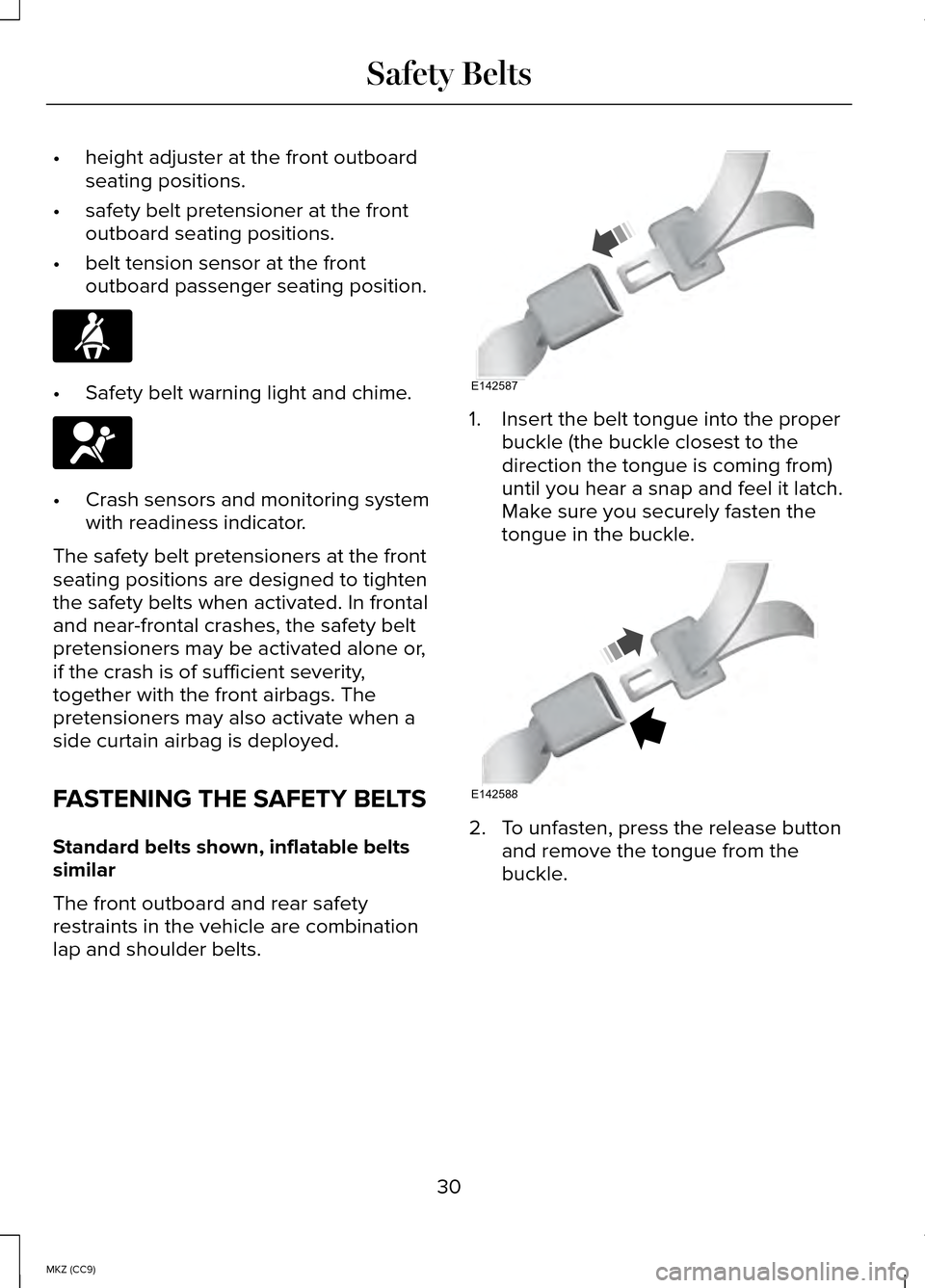
•
height adjuster at the front outboard
seating positions.
• safety belt pretensioner at the front
outboard seating positions.
• belt tension sensor at the front
outboard passenger seating position. •
Safety belt warning light and chime. •
Crash sensors and monitoring system
with readiness indicator.
The safety belt pretensioners at the front
seating positions are designed to tighten
the safety belts when activated. In frontal
and near-frontal crashes, the safety belt
pretensioners may be activated alone or,
if the crash is of sufficient severity,
together with the front airbags. The
pretensioners may also activate when a
side curtain airbag is deployed.
FASTENING THE SAFETY BELTS
Standard belts shown, inflatable belts
similar
The front outboard and rear safety
restraints in the vehicle are combination
lap and shoulder belts. 1. Insert the belt tongue into the proper
buckle (the buckle closest to the
direction the tongue is coming from)
until you hear a snap and feel it latch.
Make sure you securely fasten the
tongue in the buckle. 2. To unfasten, press the release button
and remove the tongue from the
buckle.
30
MKZ (CC9) Safety Belts E142587 E142588
Page 36 of 445

The rear inflatable safety belts are
designed to inflate in frontal or near-frontal
crashes and some side impact crashes.
The fact that the rear inflatable safety belt
did not inflate in a crash does not mean
that something is wrong with the system.
Rather, it means the forces were not of the
type sufficient to cause activation.
Safety Belt Extension Assembly
WARNINGS
Do not use extensions to change the
fit of the shoulder belt across the
torso. Do not use extensions with an
inflatable safety belt.
If the safety belt is too short when fully
extended, a safety belt extension
assembly can be obtained from an
authorized dealer.
Use only extensions manufactured by the
same supplier as the safety belt.
Manufacturer identification is located at
the end of the webbing on the label. A
safety belt extension is not available for
the inflatable safety belt. Also, use the
safety belt extension only if the safety belt
is too short for you when fully extended. SAFETY BELT HEIGHT
ADJUSTMENT WARNING
Position the safety belt height
adjusters so that the belt rests
across the middle of your shoulder. Failure
to adjust the safety belt properly could
reduce the effectiveness of the safety belt
and increase the risk of injury in a crash. Adjust the height of the shoulder belt so
the belt rests across the middle of your
shoulder.
To adjust the shoulder belt height:
1. Press the button and slide the height
adjuster up or down.
2. Release the button and pull down on the height adjuster to make sure it is
locked in place.
34
MKZ (CC9) Safety BeltsE146191
Page 39 of 445
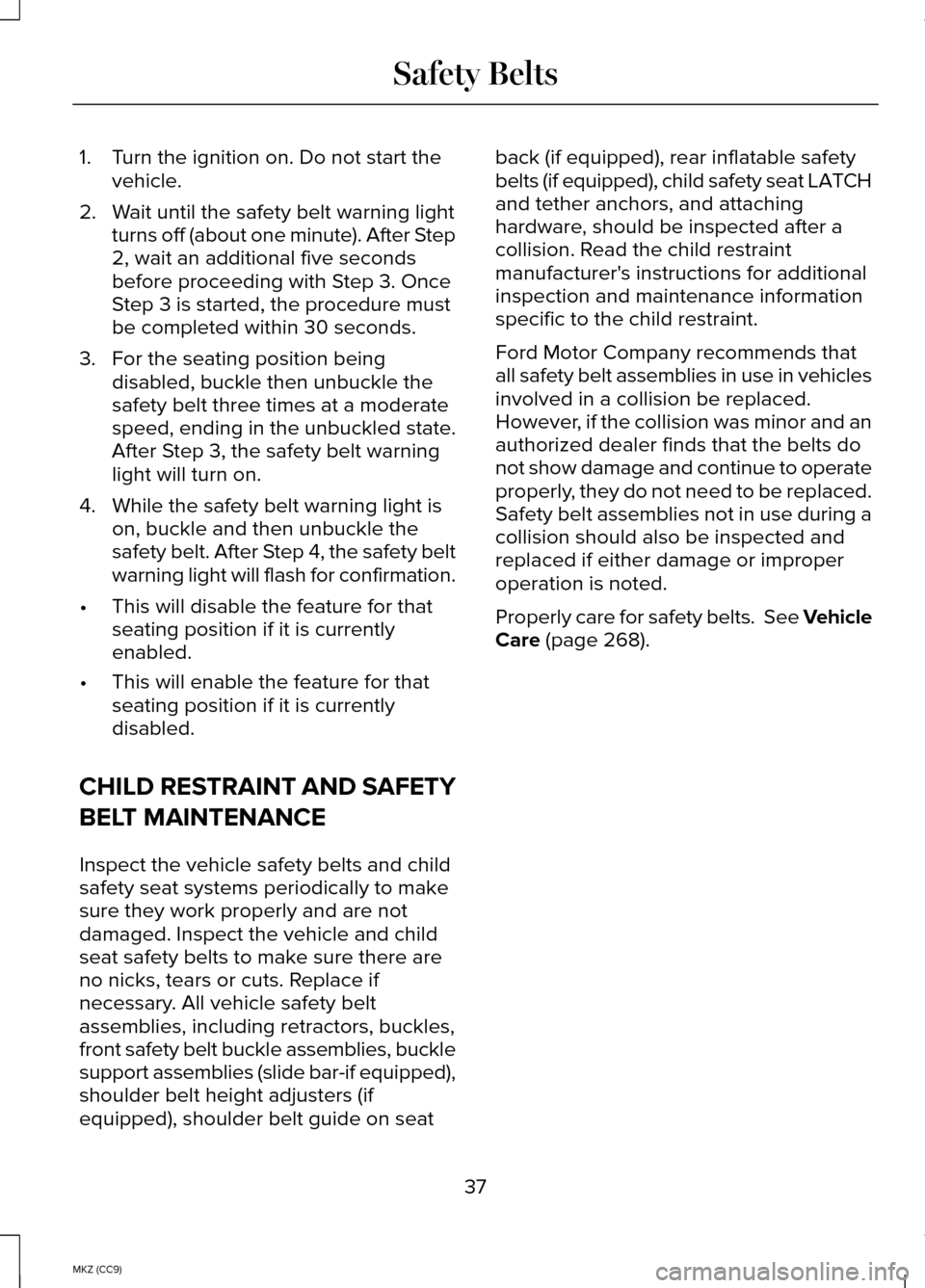
1. Turn the ignition on. Do not start the
vehicle.
2. Wait until the safety belt warning light turns off (about one minute). After Step
2, wait an additional five seconds
before proceeding with Step 3. Once
Step 3 is started, the procedure must
be completed within 30 seconds.
3. For the seating position being disabled, buckle then unbuckle the
safety belt three times at a moderate
speed, ending in the unbuckled state.
After Step 3, the safety belt warning
light will turn on.
4. While the safety belt warning light is on, buckle and then unbuckle the
safety belt. After Step 4, the safety belt
warning light will flash for confirmation.
• This will disable the feature for that
seating position if it is currently
enabled.
• This will enable the feature for that
seating position if it is currently
disabled.
CHILD RESTRAINT AND SAFETY
BELT MAINTENANCE
Inspect the vehicle safety belts and child
safety seat systems periodically to make
sure they work properly and are not
damaged. Inspect the vehicle and child
seat safety belts to make sure there are
no nicks, tears or cuts. Replace if
necessary. All vehicle safety belt
assemblies, including retractors, buckles,
front safety belt buckle assemblies, buckle
support assemblies (slide bar-if equipped),
shoulder belt height adjusters (if
equipped), shoulder belt guide on seat back (if equipped), rear inflatable safety
belts (if equipped), child safety seat LATCH
and tether anchors, and attaching
hardware, should be inspected after a
collision. Read the child restraint
manufacturer's instructions for additional
inspection and maintenance information
specific to the child restraint.
Ford Motor Company recommends that
all safety belt assemblies in use in vehicles
involved in a collision be replaced.
However, if the collision was minor and an
authorized dealer finds that the belts do
not show damage and continue to operate
properly, they do not need to be replaced.
Safety belt assemblies not in use during a
collision should also be inspected and
replaced if either damage or improper
operation is noted.
Properly care for safety belts. See Vehicle
Care (page 268).
37
MKZ (CC9) Safety Belts